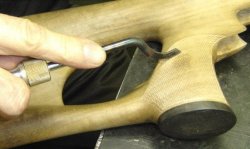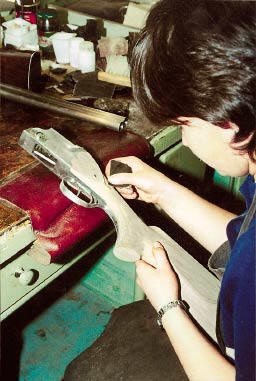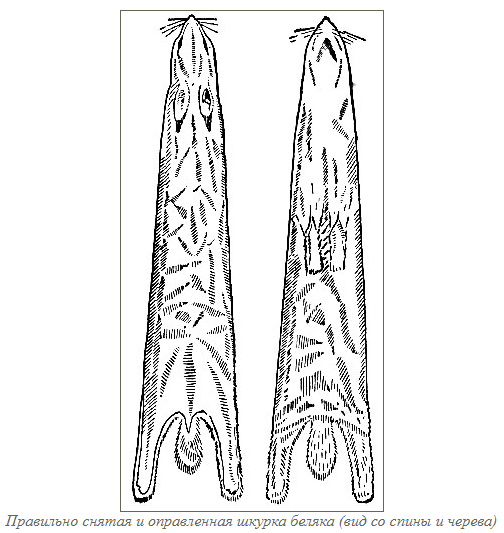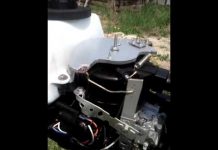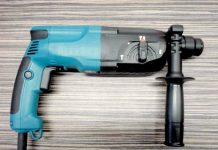In detail: do-it-yourself repair of a rifle stock from a real master for the site my.housecope.com.
Preparation for the repair of the stock of the gun and the beginning of the repair.
First you need to disassemble the gun - separate the metal parts from the wooden ones. Then clean the wooden parts of dirt, debris, grease and only then decide what exactly you will restore. To repair the box with your own hands, you need to purchase the following:
1. A set of sandpaper - from velvet to the largest.
2. Cycle (made of metal, glass).
3. Wood stain and varnish NTs-228.
4. Epoxy glue (dilute 1:10).
5. A set of wooden chocks to eliminate cracks and chips.
We acquire the missing parts in the course of work. You can repair the box with your own hands only when it dries for a week at room temperature. But you cannot dry it on a stove or a battery! We take the cycle and clean the old varnish from the forend or stock (if restoration requires it). The cycle, by the way, can be made with your own hands from window glass with a thickness of 3 mm. Once the varnish has been removed, it is advisable to carefully check the wood stock for deep scratches. They are also eliminated using a cycle. After rough processing, we clean the roughness, unevenness, etc. with sandpaper.
How to get rid of chips and deep cracks.
When the crack runs along the entire plane of the butt, it is pulled together with wooden studs with a diameter of 4 mm. We drill through holes with such a diameter so that the studs then fit tightly, and with a margin in length. We grease the gluing points and the pins themselves with epoxy glue, press them in, and wrap the contact points with tight tape with an interference fit. We are waiting at least a day for the epoxy to dry and "tightly grab" the mounted parts.
After that, we remove the screed, and cut the protruding parts of the studs and grind them “flush”. Remains of glue are removed with a sandpaper and also sanded.
| Video (click to play). |
It is much more effective to crimp the glued places with a simple special device - a tie screw. After the place of the crack is filled with glue, the tie screw is tightened and very tightly, reliably crimps the point of contact. Excess glue is squeezed out, and the crack after drying will not stick out. After the glue dries, the crack is sanded.
Now let's proceed to the restoration of the chipped stock. We process the cleavage point with a small file to a flat plane. The shape of the file depends on the location of the chip. Then we prepare the patch. Let it be slightly larger. Then it will be easy to cut it down to the desired shape. The patch and the place of the chip are covered with glue and crimped with a screed. After the glue dries, the repaired area of the stock is carefully sanded.
After repairing cracks, chips, sanding scratches, it is advisable to cover the bed with a stain. The stain is applied non-fatiguingly, but neatly and evenly. Apply the stain in several layers, after each layer you need to let it dry for 15-20 minutes. Since the stain does not lie on the varnish, the bed must be thoroughly cleaned at the first stage of the repair work. After the secondary processing of the stock with a stain, it is necessary to carefully check whether there are any poorly processed places, missed defects. After all, even a small marriage will become a gateway for rot and mold of wooden parts. After the stain has completely dried, we will continue the repair with our own hands by finishing varnishing the stock or forend.
If a notch has worn off the stock or forend, then it can be restored with your own hands. True, it takes a lot of patience and accuracy in work. First you need to make a cutter. For this purpose, a steel wire with a diameter of 2-3 mm is quite suitable. Using sandpaper and a set of files, the end of the wire is shaped into a turning tool. The angle of sharpening depends on the desired depth and thickness of the notches. The other end of the wire is secured in a homemade hard foam or wood handle. Before using the cutter on the stock, it is recommended to test it on a block of wood or a piece of plywood.
If necessary, the finishing of the cutter along the inner cutting edge is done with 00 or 0 sandpaper. The sandpaper is folded in half, with the working surface outward. Movements are carried out back and forth. When processing the outer cutting edge, the cutter should be sharpened back and forth and left and right. Naturally, it is worth applying any patterns or restoring the notch before covering the bed with stain and varnish.
Varnishing of wooden surfaces.
After repairing chips and cracks in the stock with your hands, applying notches and patterns, applying stain, it is time to varnish the wooden parts. Coating can be done with a brush or a swab. Intermediate drying of the layers is obligatory, depending on the recommendations on the varnish label. In order for a gun to look presentable after repair, there should be several layers - up to five. After each layer has dried, the varnish streaks are removed with waterproof sandpaper. If everything is done carefully, even after the dampest weather, the bed will not swell.
For complete moisture resistance, we also varnish the inner parts of the stock, which are hidden under the metal parts. It is enough to coat the inner surfaces in 2-3 layers. Cover the end of the stock to a glossy uniform layer of varnish. This ensures that moisture does not penetrate for years. After repairing the box with your own hands, the box can be polished. This will not affect the technical characteristics in any way. But after this procedure, the bed will take on the appearance of a new part.
It took a long time, about a year, but I did it all the same! 🙂 Updated the stock of my Izh-58ma. The gun, although with the EXPORT stamp in the passport, is a regular varnished birch tree.
There was also 1 significant defect that needed to be minimized.
First, I removed the varnish with a gel remover bought in a hardware store.
So, the varnish is removed, then the dent is straightened
To straighten the dent, you needed alcohol or vodka, a soldering iron, a piece of cotton cloth. It is necessary to drip alcohol onto the dent and heat it through the cloth with a soldering iron. The process was repeated 3-4 times.
Here's what happened after straightening
Then I started the impregnation with a water-based stain.
The stain is absorbed and dries quickly. Therefore, I covered it with 3 layers of stain during the day.
Further impregnation with linseed oil. Impregnated in 3 layers, once a day. Coating the tree in oil. The butt end absorbs very well. I did not become zealous in this, since the balance of the gun completely suits me. The last, third layer was dried for 5 days.
Here's what happened in the end
Later I can finish covering the tree with beeswax, time will tell.
Before the start of the spring hunting season, I decided to check how resistant the stain is to weather conditions. I put the butt under the stream of water, and went nuts, my whole hand was red 🙂 I had to urgently disassemble and process it with paraffin (the guys suggested who is engaged in restoring the butts). He melted the paraffin over a gas stove and poured it onto a preheated tree, allowing the excess paraffin to soak in and drain off. Whoever has a hair dryer, I think it will be more comfortable to work.
After such treatment, the wood practically ceased to get stained with stain. But the result of the spring hunt showed that all the same it is necessary to finish the butt. That is, it is imperative to treat it with beeswax and grind it.Hopefully by hoof season, I can do that.
So I bought beeswax and polished the stock. I liked the result. I realized that if you immediately polish with beeswax, paraffin is not needed.
The wood has acquired a glossy surface:
You must be logged in to post a comment.
You have a good gun, it has an excellent fight, but here and there it got tattered in the process of operation, cracks and chips appeared. But this does not matter, you can find a way out of this situation, there would be a desire and a hand and a little cost to purchase the necessary tools, varnish, paint, glue, etc.
First you need to disassemble the gun, that is, separate the wooden parts from the metal ones. Then clean the wooden parts of grease, dirt and debris and decide what exactly needs to be restored. In any case, you need to purchase the following:
1. Cycle (glass, metal).
2. A set of sandpaper - from the largest to velvet.
3. A set of wooden dummies for removing chips and cracks.
4. Epoxy glue (diluted 1: 10).
5. Varnish NTs-228 and wood stain.
All that is needed more will become clear during the production process. We take a cycle and remove the old varnish from the stock or forend (depending on what you decide to restore). Yes, I almost forgot, start working only with the part that has been dried for at least a week at room temperature, but in no case on the battery.
So, back to the loop. It can be made of ordinary glass with a thickness of at least 3 mm of various configurations, which will become clear during the restoration process. I don’t need to explain how to use the loops. Once you've removed the varnish, check for deep scratches, which can also be removed with a scrubber. Next, on the entire part with sandpaper, clean all the irregularities, roughness, etc.
If the crack extends across the entire plane of the butt (Fig. 1), make a tie using wooden studs with a diameter of at least 4 mm: after drilling through holes with a diameter of 4, 1 mm, adjust the studs so that they fit tightly, with a margin in length. Lubricate the bonding point, holes and pin with epoxy glue, press in the pin, pull off the bonding point with a thick fishing line or plastic tape and let the glue dry. After that, remove the tie, remove the excess length of the stud with a metal file or a hacksaw, saw down “flush” and grind. If the glue comes out, that's even good. Remaining glue can be removed with a sandpaper until the surface is similar to the rest.
Figure 2 shows the restoration of a stock with a crack, typical for the upright.
To do this, you need to prepare a tie-screw - either on your own, or with the help of a turner. The length is selected using simple measurements. The place of the crack is poured with glue and, having installed the metal part in place, the screed is pulled together until the glue is squeezed out. After the glue dries, clean it in the same way as in the first case.
Now let's deal with the restoration of a chipped stock (Fig. 3). It is necessary to process the chip with a file to a flat plane. The file must be chosen by yourself - semicircular, triangular or flat. Thus, prepare the patch, let it protrude outside. You already understood how to remove excess. Secure the patch with a tie. After the screeds are installed, the chips are repaired, the stock is sanded, cover it with a stain (brush or swab). The stain should be applied as evenly as possible, with intermediate (15-20 minutes) drying or with the time indicated on the label.
After drying, it is necessary to repeat the grinding of the part. If in some places the stain has rubbed off to the color of the wood, it is necessary to restore this coating, which corresponds to the natural color of the wood. As a rule, the stain does not form a strong layer on the varnish coating and comes off after the first stroke with a brush or a tampon.
After re-staining, carefully check if there are any gaps in your work, if all deep scratches and varnishes have been removed. Once you are convinced that the stain has laid down in an even layer, you can start varnishing the part.
LITTLE BACKGROUND: if a notch is worn out on your forend or stock, then this grief can be helped. But I must warn you that this will require maximum effort and certain skills. The cutter can be made from steel wire with a diameter of 2-2.5 mm using a set of needle files and sandpaper (Fig. 4). Carry out fine-tuning of the cutter with a simultaneous check of its capabilities on plywood. The thickness and depth of the notch depend on the size of the sharpening angle (Fig. 4, a). Make the handle of the cutter from any wood or hard foam.
Finishing the cutter along the inner cutting edge should be done with sandpaper 0 or 00, etc., folding it in half with the working part outward, and making back and forth movements. The outer cutting edge should be sharpened in a right-left and back-and-forth motion. Naturally, it is necessary to restore the notch or apply some kind of pattern before covering it with a stain.
So, the notch has been restored, the color of the wood suits you, you can varnish the part. Coating with a brush or a swab with intermediate drying of layers (the time is indicated on the varnish label). For full quality, varnishing is carried out evenly, irregularities or varnish deposits during work are removed with waterproof sandpaper, but only after the layer has completely dried. So, the coating is made until an even layer of varnish is formed, the number of layers can be from 2 to 5. The quality of this process will show itself in rainy weather: your stock or forend will not swell.
Coating must also be done from the inside to fully guarantee moisture resistance. You can apply 2-3 layers inside. The butt end of the stock is covered until a uniform layer of varnish appears. This will ensure that moisture cannot penetrate.
After you have made sure that the varnish coating suits you, sand it with a zero and finish it with a polishing paste, if you wish.
You will determine the quality of all operations yourself, according to your taste.
Time, as well as accidental scratches and blows during the hunt, leave their marks on the butts of rifles. What to do, because most hunting rifle butts, as before, are made mainly of wood.
Walnut is considered to be the best "weapon" wood. The stock, made of walnut, is light and stiff at the same time, capable of withstanding the recoil of countless charges without breaking. Beech wood is also widely used in the manufacture of butts for hunting rifles, but it is heavier than walnut wood and, moreover, lacks a texture pattern. Other types of wood used to make butts are pear, apple and wild cherry. In eastern Asia, you can find hunting rifle butts made of teak or mahogany.
Many gunsmiths impregnate wood stocks with paraffin or linseed oil, and then coat them with varnish, which to some extent protects them from minor damage and scratches.
Repairing a hunting rifle stock is not easy, especially if you need to update it after a long period of careless use.
Restoration of the butt
The reasons for the appearance of too tight contact are simple and understandable:
1) natural drying out of the butt wood, as a result of which the neck cheeks are shortened;
2) the sealing of the ends of the neck cheeks as a result of the increasing shot of the gun, which also leads to their shortening;
3) low density (looseness) of the wood of the butt.
What kind of prophylaxis should be carried out by a hunter in order to ensure that the collapse of the neck in the mentioned zone is avoided?
First of all, these are periodic inspections of the gun, especially the gap between the ends of the shank and the groove on the neck of the butt.
If there is such a gap, there is no need to worry about the fate of the neck.
If the gap has disappeared, it is necessary to separate the butt from the receiver of the gun and cut the end of the groove on the neck with a semicircular chisel of the appropriate radius.
This work can be done in two ways.
Trimming is performed with a chisel located perpendicular to the upper surface of the neck. The result is a clearly visible gap.
If you position the chisel at an angle of 60 ° to the upper surface of the neck and do not cut the upper edge of the butt end, you can get a hidden "undercut", which eliminates unwanted contact between the ends of the shank and the groove, but the gap between the shank and the butt of the neck will not be visible. With the further use of the gun, the thin edge of the wood, of course, will be compacted from the pressure of the shank, but this will not destroy the neck.
And finally, there is another major reason why the butt necks can get cracked. This is the degree of tightening of the clamping screw that pulls the stock against the receiver of the gun.
Therefore, advice: periodically check the tightness of the tightening screw. This can extend the life of the butt neck.
Frost, heat, snow, moisture, sudden temperature changes, shock loads, which are inevitable during hunting, gradually spoil the most durable wood. Sometimes the defects are so serious that they require repair or even replacement of the stock, in which case a good technician is required. But, replacing the old stock with a new one, you find that the fight of a gun or a carbine has become worse, and so much money has been given for it (stock)!
The quality of the stock has a huge impact on the accuracy of shooting. Fitted and run in to the metal parts of the stock, to a large extent, it provides a stable fight. In addition, the butt, and the stock of the carbine, is also a work of art - the main decoration of the weapon, which makes an impression not only on connoisseurs and connoisseurs.
The hunter's psyche is influenced by the design of the weapon. A beautifully designed and beautifully designed stock inexplicably gives the hunter a confident sense of superiority.
It should be borne in mind that for a rifled carbine, over many years of operation, the old stock is used to the metal parts so tightly and naturally that the new one is unlikely to provide such a fit. Therefore, do not rush to change the stock or butt. This is done only when it is no longer possible to restore the stock. This is the case when they say: "An old friend is better than two new ones."
The most common stock defect is cracks. To eliminate this defect, epoxy glue should be poured into the crack to its full depth. If a small fragment breaks off, after gluing it is pressed with a clamp to the breakaway site and kept in this position for a day until the glue is completely hardened.
When a split occurs in a large element - neck, forend or butt, the parts glued with epoxy glue must be pulled together with one or two long thin screws, having previously drilled holes for them so as not to split the wood. They should be equal in diameter to the diameter of the unthreaded screw. Before screwing in, coat the threads with epoxy glue. The screws are screwed in flush with the wood surface. The repaired part of the stock becomes stronger than it was before the breakdown.
Potholes, spalls, scorched places and other similar defects are repaired by inserting adhesives. For this, wood of the same species and texture is taken. The fibers of the gluing should be placed along the fibers of the stock.The glues should be made very carefully and slowly. The glue should be very tight, without gaps, fit into the groove carefully cut for its installation.
The place of placing the insert should not visually differ from the rest of the texture of the box. Glued timber is always stronger than non-glued timber. This operation uses a household epoxy adhesive.
After the bed with the glued-in fragment is kept under the clamp for 24 hours (time for the glue to completely solidify), the protruding parts of the fragment are processed flush with the bed.
The old, well-worn box has lost its "presentation". It is peeled, scratched, no traces of varnish are visible on it. I would like to give it a beautiful appearance. The same must be done with the new stock. First, the stock is cleaned with medium-grained sandpaper. Grind the scratches, remove the remnants of the old varnish. After that, the stock is sanded with fine emery paper, and then with the finest "micron".
After polishing, the stock is moistened with water, wiped dry, dried and again carefully polished with a micron. This operation allows you to remove small burrs of the wood, which, after drying, "ruffle", they are removed by "micron". It so happens that this operation has to be repeated several times, it all depends on the texture of the wood.
After the last sanding, the stock is covered with a stain. If there is a desire to have a stock of dark color with a thick shade, let the stain dry and cover a second time. A light stock made of birch becomes dark, elegant, similar to a stock made of expensive woods. The same can be done with stocks made of beech or hornbeam. The walnut itself is beautiful and noble, with an original structure and does not need coloring.
It should be borne in mind that the inner surfaces of the rifle stock, mated with metal parts (barrel and receiver), are not sanded and stained.
When repairing rifle stocks, it is advisable to use the experience of repairing rifled stocks.
Below are all the methods and methods of repairing the stocks of smooth-bore rifles discovered by the author in print.
Bonding cracks in the stock of the gun
V.N. Trofimov sets out the following methods for repairing boxes.
If the crack is small, then it must be slightly wedged, pour waterproof epoxy glue into it, wait for it to flow inside it, remove the wedge and tighten the stock with a clamp or twist until the edges of the crack are completely closed.
After a day, the clamp or twist is removed and the beads of the protruding glue are removed with a file or cycles. If the crack is large, that is, the piece of the stock has practically broken off, then it is necessary to pull this part into place with the corresponding size screws, the holes for which must be drilled so that their heads are recessed into the wood by 3.5 mm.
♦ the surfaces to be glued are cleaned of dirt, put together as they should be glued, and holes are drilled for screws;
♦ glued surfaces are separated, degreased, lubricated with waterproof epoxy glue, connected and tightened with screws;
♦ After drying, the holes above the screw heads are sealed with the same glue mixed with wood dust (prepared with a file or sandpaper).
In the case when the small thickness of the flake does not allow fixing it with recessed screws, but it is impossible to simply glue the flake, since it will not hold for a long time (an example is the flakes at the junctions of the wood of the box and the metal of the block), then you have to put wooden bushings.
This is done as follows:
♦ the lagging part is drilled with a 4-5mm drill through and through and penetrate into the wood by 1-15mm (if the thickness in this place does not allow drilling to this depth, then it is drilled through and through);
♦ the hole is passed with a tap of the appropriate diameter and the thread is cut;
♦ a rod with a diameter slightly larger than the diameter of the drill is cut from a piece of suitable wood and a thread is cut on it with a die corresponding to the tap;
♦ a wooden bolt made in this way is coated with epoxy glue and screwed into the prepared hole, attracting the flake to the bed (the chip surface is also glued);
♦ when the glue hardens, cut off the protruding excess of the rod. When sealing potholes and gouges with a tree, guns proceed in the same way as when filling holes above the screw heads, having previously prepared the surface to be treated.
If the size of the pothole putty to be poured is large, then several small screws must be screwed into the bottom of the damage to such a depth that their heads disappear into the thickness of the putty when pouring.
Rice. Sealing of potholes in the stock of the gun
To eliminate the defect, you must:
♦ separate metal from wood;
♦ if the neck is not broken in half, but only one cheek has fallen off, it is necessary to act as described above (chipping of the stock), with the only addition that in addition to the screws, you will have to put another bolt tie between the cheeks;
♦ in case of a transverse fracture of the neck of the box, the halves are connected and two channels with a diameter of 5-7 mm are drilled along the length so that they go through the broken part and enter the main one by 70 millimeters;
♦ The surfaces to be glued are prepared as usual: the surfaces are lubricated with epoxy glue, then it is poured into the drilled channels, the parts are connected and tightened with powerful screws screwed into the channels;
♦ After hardening, the glue is removed from all surfaces.
If the bed has fallen apart into several pieces, they are connected together not only with glue, but also with metal pins in the back. It is best to use pieces of screws of the correct diameter for the pins.
Rice. Correction of a fracture of the neck of the box (top and side view)
At our arms factories, the boxes are coated with varnish, which has significant drawbacks. In warm weather, the hands sweat more than usual on contact with the lacquered surface of the box. In winter, the lacquered bed is unpleasantly cold on the hands and cheek. The second major drawback is fragility. Moisture penetrates through deep scratches, which contributes to the peeling of the varnish from the surface of the wood. Such a bed takes on an unpresentable look and needs protection.
Below are the methods of cosmetic repair of the boxes.
A. Weissman proposes the following way to cover the box.
♦ separate all wooden parts of the box from metal;
♦ remove old coating, scratches and small cracks from wooden parts by scraping;
♦ to glue or repair deep cracks;
♦ "lift" the net on the forend and the neck of the stock. This is done following the old tracks using a triangular file. If the notch has worn off without a trace, or it was not there at all, then it is applied with a simple tool made of two slotting blades fastened together through gaskets. The thickness of the spacer is adjusted to the desired spacing between the notches. A large mesh looks rough, artisanal, while a small mesh easily crumbles. Therefore, there must be a golden mean. The grid is being finalized with a triangular file;
♦ sand the surface in descending order of numbers;
♦ change the color of the box (if desired). The light color of the stock can be changed to dark. For this purpose, you can use a commercially available alcohol or other stain, or you can make it yourself. The composition of the solution: potassium permanganate - 3 g, Glauber's salt - 3 g, water - 100 g. The solution must be allowed to stand for two days, then poured into a bowl and corked. A very good result is obtained by coloring the tree with a strong decoction of walnut partitions. Before painting, the stock must be slightly moistened. The most uniform color is achieved when the product is immersed in a solution, while the color intensity is directly proportional to the number of immersions;
♦ to see off the box.To do this, it is necessary to prepare a solution of the following composition: beeswax - 10 g, gasoline - 100 g. The resulting solution is applied with a cloth in an even layer to the wood. After that, the stock is kept until the gasoline has completely evaporated;
♦ rub the wax with a cloth into the wood heated over the fire to plus 40-50 °. This operation must be repeated three to four times. After applying the last layer, the bed does not warm up, and all surfaces must be polished with a cloth. After such processing, the wooden parts of the gun will be less sensitive to mechanical damage and more moisture resistant.
The following method of protection deserves attention: the tree is covered with natural linseed oil and evenly heated over a heat source (best of all, over the hotplate of an electric stove) so that the drying oil does not smoke, but, slightly bubbling, is absorbed into the wood. The deeper into the thickness of the tree the impregnation goes, the better. The operation is repeated 10-12 times, after which the wooden parts dry in a dust-protected secluded place for two weeks. After drying, the bed is covered with a composition cooked from the following components: take in equal proportions natural beeswax, gum (resin of an apple, pear, cherry or plum, acting in the form of drips on the bark) and rosin, dissolve everything in a water bath (the saucepan is not placed on open fire, and in a large bowl with boiling water), filter it hot, add turpentine in such an amount that, after cooling, the composition resembles liquid varnish in consistency. When applied to a dried bed of the solution, the first few times it will be absorbed into the wood, then a surface layer will form.
After that, the wood is dried until the sticky sensation disappears when touched.
After drying, the wooden surface is polished by vigorously rubbing it with a cloth.
After such treatment, the bed becomes absolutely waterproof, very beautiful to look at and warm to the touch. These properties are preserved for years with intensive use of weapons.
An experienced looser A. Posudin recommends the following method to protect stocks made of walnut.
To carry out the operation, you must have sandpaper of three grades: medium, fine and very fine grain, as well as PVC-based insulating tape.
When processing wooden parts, they can not be separated, but it is imperative to glue with strips of electrical tape those places on the metal surface of the weapon that are adjacent to the wooden parts. With this protection, abrasive grains will not touch oxidized metal surfaces and leave light scratches on them. Otherwise, they will have to be sanded and oxidized.
In addition, uncoupled wooden parts allow control over the degree of wood removal at the points of contact between wood and metal. It is also recommended to glue the notch on the neck of the stock and on the fore-end, so as not to sand down its sharp edges.
Further, the process is carried out in the following order:
♦ the varnish is removed. Removal is performed by movement only along the direction of the fibers. The movement across the grain leaves streaks that remain visible on the finished stock even though the surface is perfectly smooth. The varnish is removed first with medium-hard sandpaper. Those places where the notch has a zigzag contour is processed with sandpaper folded several times, so that it forms a solid corner;
♦ inspection of the processed surface of the parts. If the scratches and nicks are so deep that they did not disappear after processing, then proceed to the next operation;
♦ “tree” is removed in the area of this defect until it disappears completely. Removal is carried out either with files, moving from a large notch to a smaller one, or with sandpaper wrapped around a rectangular wooden block. For these purposes, it is undesirable to use a cycle, especially if the scratch is located across the fiber.The fact is that the sharp edge of the cycle will fall into this scratch and thereby deepen it;
♦ the surface is processed with fine emery paper (grinding), then "micron" - sandpaper with such a fine abrasive that the working surface seems velvety to the touch;
♦ impregnation of wooden parts of the box is carried out. It is advisable for this purpose to use the highest quality liquid drying oil, made on the basis of linseed oil. Special artistic flaxseed oil, which can be purchased at an artist store, is also suitable. Or, you can use regular (refined) sunflower oil.
The impregnation technology is simple. 15–20 drops of oil are poured onto the left palm and rubbed between the palms. Next, you should wipe the bed with both palms from all sides repeatedly. The first layer of oil is absorbed very quickly, especially in those places where the ends of the wood fibers are cut. The impregnation must be repeated until the oil ceases to penetrate into the wood.
Under no circumstances should the soaked stock be held over the flame of a gas burner or a soldering lamp.
py. This will not lead to anything good. Wood is capable of such unpredictable deformations that the gun can become unusable. Walnut wood begins to darken after the substance it contains reacts with linseed oil. This process is especially intense when sunlight hits the bed;
♦ the bed impregnated with linseed oil is dried;
♦ after this the bed is polished with a cloth with movements along the grain. To give the bed even more
gloss is polished with a stick of boxwood (or other very hard wood). As an exception, you can polish with a metal rod with a mirrored surface. It is repeatedly carried out on the smooth surfaces of the box, bypassing those places where there is a notch. After this treatment, the stock looks like varnished.
The hunting rifle is the main character of the hunt. A real hunter treats hunting weapons with respect. And damage to the butt of a hunting rifle is not a reason to write it off. The article describes how to repair a hunting rifle stock at home. Any hunter with perseverance and desire is able to repair the butt of a hunting rifle at home.
Every hunter can honestly say that hunter without a gun - like a shoemaker without boots. Shotgun - the main character of the hunt, and the main outcome of the hunting event - the volume of production - depends on what it is and in what state it is. Time, as well as accidental scratches and bumps during the hunt, leave their marks on the butts of our hunting rifles. What to do, because most hunting rifle butts, as before, are made mainly of wood. However, damage to the butt of a hunting rifle is not a reason to write it off. We will tell you how to do repair of the butt of a hunting rifle at home. Any hunter with perseverance and desire is able to carry out repair of the butt of a hunting rifle at home.
Walnut is considered to be the best weapon wood. The stock of a hunting rifle, made of walnut, is both light and stiff, capable of withstanding the recoil of countless charges without destruction. And the texture of wood is pleasing to the eye, especially if it has a dark color and a pronounced texture. Rich plantations of such a gunnut are located on the Black Sea coast of Turkey. European walnut is much lighter, so the stocks made from it are tinted. In the manufacture of butts for hunting rifles, beech wood is also widely used, but it is heavier than walnut and, moreover, lacks a texture pattern. Other types of trees that are taken for the production of hunting rifle butts are pear, apple and wild cherry. In East Asia, you can find hunting rifle butts made of teak or mahogany.
Many gunsmiths soak wood stocks with paraffin or linseed oil and then coat them with varnish, which, to some extent, keeps them from light damage and scratches.
Hunting rifle stock repair - the matter is not at all simple, especially if you need to update it after a long period of careless exploitation.
The first operation to repair the butt of a hunting rifle - this is the removal of all metal parts from it and cleaning from the residues of paraffin and oil. To do this, you can safely use soap, boiling water and a hard clothes brush. Flushing the butt of a hunting rifle should be alternated with drying in the sun. For varnished stocks, repairs begin with removing the varnish with some kind of solvent.
Now you can proceed to the second stage of repairing the butt of a hunting rifle - restoration of its surface, i.e. removing scuffs, chips, scratches and dents:
- We fight with the dents of the butt of a hunting rifle as follows. With a cotton swab, apply a solution consisting of equal parts of water and glycerin (or water and denatured alcohol) to the defective area. After the wood has been impregnated, we put a piece of cotton cloth in place of the dent and iron the stock through it with a heated soldering iron. The area of the depressed tree should be straightened out. For deep dents, this operation is performed several times.
- Scratches and scratches from the surface of the butt of a hunting rifle can be removed with sandpaper. To do this, it is advisable to purchase a soft abrasive swab, since a sandpaper applied to a wooden block can disturb the original profile of the butt of a hunting rifle. A deep chip is covered with glue with a wooden insert, then the damaged area is leveled and sanded. It is better to use glue with resin, which is used in shipbuilding. In some cases, it will be useful to tint the butt of a hunting rifle in a darker color, or, highlighting the wood pattern, to close the places of restoration with separate strokes.
The final finishing of the butt of a hunting rifle after its repair is to impregnate it with linseed oil or shellac polish and dry it. The final touch is to apply a layer of natural oil varnish to the surface of the stock and, on top of it, a wax polish. Your gun is now as good as new.
Previous articles on this topic:
Register to get an account. It's simple!
Already Registered? Sign in here.
Nobody got a reputation in a week
Woodcock hunting is the most interesting and exciting sports and recreational hunting with a gun.
A distinctive feature of this process is accessibility to every person who wants to hunt. The woodcock is widespread almost throughout the country, and it is for this reason that the woodcock has become a very popular bird for hunting. The competitive element of hunting for this bird attracts a wide variety of hunters: both urban and rural. Young novice hunters also look for woodcock habitats with great pleasure, and experienced hunters will never miss the evening, so as not to go and shoot at their leisure at the woodcock.
Woodcock lives and nests in woodlands, therefore it is in the forest that the main hunting processes take place: they hunt birds in spring, autumn, on bird flights, with dogs through mud and water - and all this against the backdrop of a stunning forest landscape.
A hunting hobby allows the hunter to get closer to the Russian forest, the inhabitants of the thickets, and unique natural landscapes. Here, not only the love for hunting and all its moments is brought up, but also the love for the magnificent unique Russian nature with its splendor, bright colors and originality.
This book tells about the ways and methods of hunting woodcock. The publication was created thanks to thirty years of experience in hunting wood sandpipers in various parts of the vast country.The author's task was to show novice hunters the uniqueness of this bird, to tell about its habits, conditions of nesting and flights, about how to prepare and equip yourself for such a difficult but fascinating business as woodcock hunting. The author shares the hunting technique, methods of high-quality shooting, the features of the necessary equipment and the breeds of dogs that will become the best helpers in this lesson.
The book will help both a novice hunter and an experienced professional: it will reveal the secrets of hunting for the forest sandpiper and the most intimate secrets of this unusual hobby.
| Video (click to play). |


There is no such hunter who would not be on the spring hunt. But what is hunting without a decoy duck? The first-year hunter immediately has questions: what is the best way to hunt, why does the duck not work, why does one have a trophy, while the other does not? You will find the answers to all questions in this book, and the knowledge you have acquired will help you properly prepare for the hunt and prevent possible mistakes. The book is intended for young hunters and a wide range of hunting enthusiasts.
Please share your impressions of the book and the sound quality.


